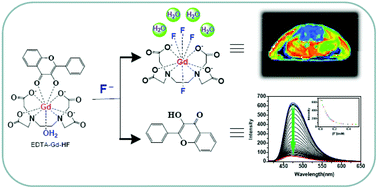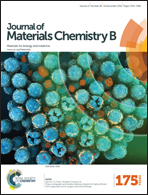Fluoride-specific fluorescence/MRI bimodal probe based on a gadolinium(iii)–flavone complex: synthesis, mechanism and bioimaging application in vivo†
Abstract
Molecular imaging is a powerful tool to visualize cellular processes and activity levels of biomarkers at the cellular and molecular level, in which a molecular probe is a prerequisite for the molecular imaging technique. The present work reports a bimodal probe for the fluorescence and magnetic resonance detection of fluoride ions (F−) in aqueous media and in vivo. The bimodal probe, EDTA–Gd–HF, was prepared by self-assembly of the EDTA–Gd complex with 3-hydroxyflavone (HF). In the system, HF plays the role of spectroscopic reporter and Gd(III) serves as a MRI signal output unit as well as the fluoride ion binding site. Upon addition of fluoride ions into an aqueous solution of EDTA–Gd–HF, the replacement of one coordinated water molecule and then liberation of HF led to remarkable spectroscopic recovery and distinct changes to the longitudinal relaxivity (r1), by which fluorescence/MRI bimodal fluoride ion sensing was achieved. In vivo magnetic resonance imaging (MRI) in mice indicates that EDTA–Gd–HF can be potentially used in biomedical diagnosis and therapy fields.



 Please wait while we load your content...
Please wait while we load your content...